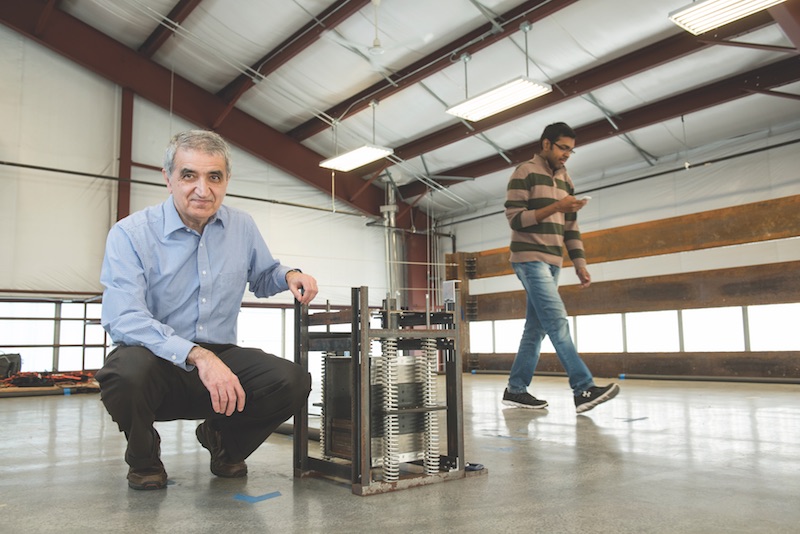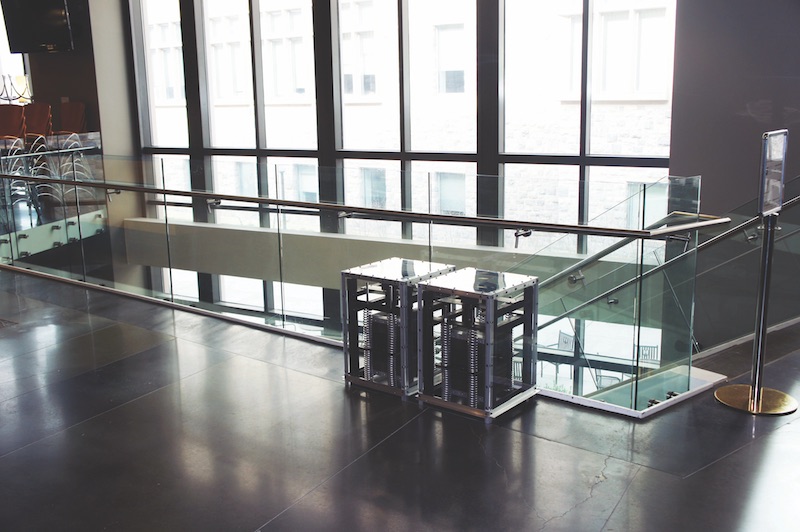The tuned mass damper used in Taiwan’s Taipei 101 tower represents an engineering feat that is so impressive the designers decided to make it publicly visible for all to see. Taipei 101’s 730-ton tuned mass damper may represent an extreme, but its purpose is the same as much smaller dampers that may be used in an office building or mall: to mitigate vibrations or sway that may otherwise alarm or cause discomfort to building occupants.
As building materials get lighter and designs push the limits of what is possible in architecture, structural vibrations are becoming more worrisome. A vibrating floor may not be dangerous, but it can certainly cause some unease among building occupants.
That’s where Mehdi Setareh, PhD, Professor, School of Architecture + Design at Virginia Tech’s College of Architecture and Urban Studies, comes in. With the help of a small team of students, he has created a portable tuned mass damper (PTMD) that weighs less than 275 pounds and is about the size of a shop vac. The device reduced vibrations by 40-75% in tests at Virginia Tech’s Vibration Testing Lab.
 Mehdi Setareh next to an early version of the Portable Tuned Mass Damper. Courtesy Virginia Tech.
Mehdi Setareh next to an early version of the Portable Tuned Mass Damper. Courtesy Virginia Tech.
The PTMD can be incorporated in new construction or added as a corrective measure in an existing building. Even nontechnical personnel can tune the device, using a $5 iTunes application and Setareh’s instructions. Because of the device’s small size, it can be easily hidden in a cabinet or even within furniture.
Plates, springs, and dampers that are built into the two-foot-tall, 15-inch-wide box are tuned to the natural frequency of a structure and reduce vibrations by moving in the opposite direction of that structure, but at 10 to 20 times higher acceleration rates.
Currently, the unit shows the most promise for use in structures with high foot traffic, such as theaters, malls, nightclubs, and monumental staircases, or in settings that have vibration-sensitive equipment, such as hospitals and labs.
Setareh has applied for a patent on the device. He plans to place it on the market as a kit of parts with instructions on how to assemble, install, and tune the damper.
Related Stories
Metals | Sep 11, 2023
Best practices guide for air leakage testing for metal building systems released
The Metal Building Manufacturers Association (MBMA) released a new guidebook, Metal Building Systems - Best Practices to Comply with Whole-Building Air Leakage Testing Requirements.
Building Owners | Aug 23, 2023
Charles Pankow Foundation releases free project delivery selection tool for building owners, developers, and project teams
Building owners and project teams can use the new Building Owner Assessment Tool (BOAT) to better understand how an owner's decision-making profile impacts outcomes for different project delivery methods.
Fire-Rated Products | Aug 14, 2023
Free download: Fire-rated glazing 101 technical guide from the National Glass Association
The National Glass Association (NGA) is pleased to announce the publication of a new technical resource, Fire-Rated Glazing 101. This five-page document addresses how to incorporate fire-rated glazing systems in a manner that not only provides protection to building occupants from fire, but also considers other design goals, such as daylight, privacy and security.
Digital Twin | Jul 31, 2023
Creating the foundation for a Digital Twin
Aligning the BIM model with the owner’s asset management system is the crucial first step in creating a Digital Twin. By following these guidelines, organizations can harness the power of Digital Twins to optimize facility management, maintenance planning, and decision-making throughout the building’s lifecycle.
Sustainability | Jul 26, 2023
Carbon Neutrality at HKS, with Rand Ekman, Chief Sustainability Officer
Rand Ekman, Chief Sustainability Officer at HKS Inc., discusses the firm's decarbonization strategy and carbon footprint assessment.
Sponsored | Fire and Life Safety | Jul 12, 2023
Fire safety considerations for cantilevered buildings [AIA course]
Bold cantilevered designs are prevalent today, as developers and architects strive to maximize space, views, and natural light in buildings. Cantilevered structures, however, present a host of challenges for building teams, according to José R. Rivera, PE, Associate Principal and Director of Plumbing and Fire Protection with Lilker.
Mass Timber | Jul 11, 2023
5 solutions to acoustic issues in mass timber buildings
For all its advantages, mass timber also has a less-heralded quality: its acoustic challenges. Exposed wood ceilings and floors have led to issues with excessive noise. Mass timber experts offer practical solutions to the top five acoustic issues in mass timber buildings.
Green | Jun 26, 2023
Federal government will spend $30 million on novel green building technologies
The U.S. General Services Administration (GSA), and the U.S. Department of Energy (DOE) will invest $30 million from the Inflation Reduction Act to increase the sustainability of federal buildings by testing novel technologies. The vehicle for that effort, the Green Proving Ground (GPG) program, will invest in American-made technologies to help increase federal electric vehicle supply equipment, protect air quality, reduce climate pollution, and enhance building performance.
Mechanical Systems | Jun 16, 2023
Cogeneration: An efficient, reliable, sustainable alternative to traditional power generation
Cogeneration is more efficient than traditional power generation, reduces carbon emissions, has high returns on the initial investment, improves reliability, and offers a platform for additional renewable resources and energy storage for a facility. But what is cogeneration? And is it suitable for all facilities?
AEC Innovators | Jun 15, 2023
Rogers-O'Brien Construction pilots wearables to reduce heat-related injuries on jobsites
Rogers-O'Brien Construction (RO) has launched a pilot program utilizing SafeGuard, a safety-as-a-service platform for real-time health and safety risk assessment. Non-invasive wearables connected to SafeGuard continuously monitor personnel to prevent heat exhaustion on jobsites, reducing the risk of related injuries. RO is the first general contractor to pilot this program.

















